Spatiotemporal Variations of Production–Living–Ecological Space under Various, Changing Climate and Land Use Scenarios in the Upper Reaches of Hanjiang River Basin, China
Abstract
:1. Introduction
2. Materials and Methods
2.1. Study Area
2.2. Research Framework
2.3. Data Sources
- (1)
- Meteorological observation data of the national meteorological stations in the URHR and the surroundings during the historical period (2000–2020) were derived from the Chinese surface meteorological observation dataset released by China Meteorology Administration.
- (2)
- CMIP 6 climate model data for the future period (2021–2100) were obtained from daily data of the global climate models of the World Climate Research Program under the SSP2-4.5 and SSP5-8.5 scenarios.
- (3)
- Land use data in historical period (2000–2020) were from the global ESA Land Cover dataset ESA CCI Land Cover project released by the European Space Agency (ESA).
- (4)
- In the simulation of land use in the future period, the main data are land use data in the base period, prediction data in the future climate scenarios, soil data, topographic data (DEM), and socio-economic data (raw data of population, GDP, city center and transportation network elements). The slope and aspect data are obtained through DEM data processing. Resulting from the traffic network data, the driving factors including the distance data to places such as the city center, town center, expressway, airport, river, railway station, railway and traffic artery in the simulation of land use are generated through GIS.
2.4. Methods
2.4.1. Future Climate Scenarios
- (1)
- The selection of climate scenarios:
- (2)
- Download data in two scenarios of 27 models from the Global Climate Model (GCM) output of CMIP6.
- (3)
- (4)
- The correlation coefficient between projected and observed data is evaluated through the quantitative index S of the Taylor Chart [54,55,56], the spatial skill score is used to evaluate the spatial correlation coefficient between projected and observed data [57], and the temporal skill score is quantified to assess the simulation efficiency of the projected value at each point in the space to simulate the inter-annual change of the observed value [58,59,60]. The two models, UKES and MIR2, were selected based on the ranking of the total scores. Therefore, with multi-model ensemble mean approaches [61,62], the average value of the two models was obtained as the prediction data in the future climate scenarios.
2.4.2. Land Use Simulation
2.4.3. Classification System and Functional Measurement of PLES
3. Results
3.1. Spatio-Temporal Variations in Land Use and PLES
3.1.1. Variations in Land Use and PLES in Historical Period
3.1.2. Variations of Future PLES under Different Scenarios
3.2. Transfer Evolution of Land Use and PLES under Different Scenarios
3.2.1. Evolution Characteristics of Land Use in the URHR
3.2.2. Evolution Characteristics of PLES in the URHR
3.2.3. Evolution Characteristics of Land Use in Sub Basins
3.2.4. Evolution Characteristics of PLES in Sub Basins
3.3. Functional Measurement of PLES in Different Land Use and Climate Scenarios
3.3.1. Spatial Variations of PLESI
3.3.2. Temporal Variations of PLESI
4. Discussion
4.1. Implications of Land Use Multifunctionality Assessment
4.2. Implications of Scenario Analysis for PLES
4.3. PLES Management Implementation
4.4. Limitations and Future Research
5. Conclusions
Author Contributions
Funding
Data Availability Statement
Conflicts of Interest
References
- Verburg, P.H.; van de Steeg, J.; Veldkamp, A.; Willemen, L. From land cover change to land function dynamics: A major challenge to improve land characterization. J. Environ. Manag. 2009, 90, 1327–1335. [Google Scholar] [CrossRef] [PubMed]
- Fu, B.; Zhang, L.; Xu, Z.; Zhao, Y.; Wei, Y.; Skinner, D. Ecosystem services in changing land use. J. Soil Sediment. 2015, 15, 833–843. [Google Scholar] [CrossRef]
- Siddique, M.N.E.A.; Lobry de Bruyn, L.A.; Osanai, Y.; Guppy, C.N. Determining the role of land resource, cropping and management practices in soil organic carbon status of rice-based cropping systems. Agric. Ecosyst. Environ. 2023, 344, 108302. [Google Scholar] [CrossRef]
- Lilburne, L.; Eger, A.; Mudge, P.; Ausseil, A.-G.; Stevenson, B.; Herzig, A.; Beare, M. The Land Resource Circle: Supporting land-use decision making with an ecosystem-service-based framework of soil functions. Geoderma 2020, 363, 114134. [Google Scholar] [CrossRef]
- Lourenço, I.B.; Guimarães, L.F.; Alves, M.B.; Miguez, M.G. Land as a sustainable resource in city planning: The use of open spaces and drainage systems to structure environmental and urban needs. J. Clean. Prod. 2020, 276, 123096. [Google Scholar] [CrossRef]
- Dorninger, C.; von Wehrden, H.; Krausmann, F.; Bruckner, M.; Feng, K.; Hubacek, K.; Erb, K.-H.; Abson, D.J. The effect of industrialization and globalization on domestic land-use: A global resource footprint perspective. Glob. Environ. Chang. 2021, 69, 102311. [Google Scholar] [CrossRef]
- Furtado, I.S.; Martins, M.B. The impacts of land use intensification on the assembly of drosophilidae (Diptera). Glob. Ecol. Conserv. 2018, 16, e00432. [Google Scholar] [CrossRef]
- Almulhim, A.I.; Cobbinah, P.B. Can rapid urbanization be sustainable? The case of Saudi Arabian cities. Habitat Int. 2023, 139, 102884. [Google Scholar] [CrossRef]
- Thaweepworadej, P.; Evans, K.L. Urbanisation of a growing tropical mega-city during the 21st century—Landscape transformation and vegetation dynamics. Landsc. Urban Plan. 2023, 238, 104812. [Google Scholar] [CrossRef]
- Kangas, K.; Brown, G.; Kivinen, M.; Tolvanen, A.; Tuulentie, S.; Karhu, J.; Markovaara-Koivisto, M.; Eilu, P.; Tarvainen, O.; Simila, J.; et al. Land use synergies and conflicts identification in the framework of compatibility analyses and spatial assessment of ecological, socio-cultural and economic values. J. Environ. Manag. 2022, 316, 115174. [Google Scholar] [CrossRef]
- Baldini, C.; Marasas, M.E.; Tittonell, P.; Drozd, A.A. Urban, periurban and horticultural landscapes—Conflict and sustainable planning in La Plata district, Argentina. Land Use Policy 2022, 117, 106120. [Google Scholar] [CrossRef]
- Zhang, K.; Wei, W.; Yin, L.; Zhou, J. Spatial-Temporal Evolution Characteristics and Mechanism Analysis of Urban Space in China’s Three-River-Source Region: A Land Classification Governance Framework Based on “Three Zone Space”. Land 2023, 12, 1380. [Google Scholar] [CrossRef]
- Liu, J.; Liu, Y.; Li, Y. Classification evaluation and spatial-temporal analysis of “Production–Living–Ecological” spaces in China. Acta Geol. Sin. 2017, 72, 1290–1304. [Google Scholar]
- Li, C.; Wu, J. Land use transformation and eco-environmental effects based on Production–Living–Ecological spatial synergy: Evidence from Shaanxi Province, China. Environ. Sci. Pollut. Res. Int. 2022, 29, 41492–41504. [Google Scholar] [CrossRef] [PubMed]
- Ma, Q.; Wang, Z.; Zhao, Y. Evolution of Spatial-Temporal Pattern and Functional Measurement of “Production–Living–Ecological” Space in Xi’an, China. Mt. Res. 2021, 39, 722–733. [Google Scholar] [CrossRef]
- Chen, J.; Fu, H.; Chen, S. Multi-Scenario Simulation and Assessment of Ecosystem Service Value at the City Level from the Perspective of Production–Living–Ecological-Spaces: A Case Study of Haikou, China. Land 2023, 12, 1021. [Google Scholar] [CrossRef]
- Zou, L.; Liu, Y.; Yang, J.; Yang, S.; Wang, Y.; Cao, z.; Hu, X. Quantitative identification and spatial analysis of land use ecological-production-living functions in rural areas on China’s southeast coast. Habitat Int. 2020, 100, 102182. [Google Scholar] [CrossRef]
- Liu, X.; Wang, X.; Chen, K.; Li, D. Simulation and prediction of multi-scenario evolution of ecological space based on FLUS model: A case study of the Yangtze River Economic Belt, China. J. Geogr. Sci. 2023, 33, 373–391. [Google Scholar] [CrossRef]
- Jin, X.; Lu, Y.; Lin, J.; Qi, X.; Hu, G.; Li, X. Research on the evolution of spatiotemporal patterns of Production–Living–Ecological space in an urban agglomeration in the Fujian Delta region, China. Acta Ecol. Sin. 2018, 38, 4286–4295. [Google Scholar]
- Song, Y.; Xia, S.; Xue, D.; Luo, S.; Zhang, L.; Wang, D. Land Space Change Process and Its Eco-Environmental Effects in the Guanzhong Plain Urban Agglomeration of China. Land 2022, 11, 1547. [Google Scholar] [CrossRef]
- Wang, A.; Liao, X.; Tong, Z.; Du, W.; Zhang, J.; Liu, X.; Liu, M. Spatial-temporal dynamic evaluation of the ecosystem service value from the perspective of “Production–Living–Ecological” spaces: A case study in Dongliao River Basin, China. J. Clean. Prod. 2022, 333, 130218. [Google Scholar] [CrossRef]
- Zhao, J.; Zhao, Y. Synergy/trade-offs and differential optimization of production, living, and ecological functions in the Yangtze River economic Belt, China. Ecol. Indic. 2023, 147, 109925. [Google Scholar] [CrossRef]
- Zhou, D.; Xu, J.; Lin, Z. Conflict or coordination? Assessing land use multi-functionalization using production-living-ecology analysis. Sci. Total. Environ. 2017, 577, 136–147. [Google Scholar] [CrossRef] [PubMed]
- Turner, B.L.; Lambin, E.F.; Reenberg, A. Land Change Science Special Feature: The emergence of land change science for global environmental change and sustainability. Proc. Natl. Acad. Sci. USA 2008, 105, 2751. [Google Scholar] [CrossRef]
- Musakwa, W.; Wang, S. Landscape change and its drivers: A Southern African perspective. Curr. Opin. Environ. Sust. 2018, 33, 80–86. [Google Scholar] [CrossRef]
- Domingo, D.; Palka, G.; Hersperger, A.M. Effect of zoning plans on urban land-use change: A multi-scenario simulation for supporting sustainable urban growth. Sustain. Cities Soc. 2021, 69, 102833. [Google Scholar] [CrossRef]
- Molinero-Parejo, R.; Aguilera-Benavente, F.; Gómez-Delgado, M.; Shurupov, N. Combining a land parcel cellular automata (LP-CA) model with participatory approaches in the simulation of disruptive future scenarios of urban land use change. Comput. Environ. Urban Syst. 2023, 99, 101895. [Google Scholar] [CrossRef]
- Bacău, S.; Domingo, D.; Palka, G.; Pellissier, L.; Kienast, F. Integrating strategic planning intentions into land-change simulations: Designing and assessing scenarios for Bucharest. Sustain. Cities Soc. 2022, 76, 103446. [Google Scholar] [CrossRef]
- Liu, X.; Liang, X.; Li, X.; Xu, X.; Ou, J.; Chen, Y.; Li, S.; Wang, S.; Pei, F. A future land use simulation model (FLUS) for simulating multiple land use scenarios by coupling human and natural effects. Landsc. Urban Plan. 2017, 168, 94–116. [Google Scholar] [CrossRef]
- Liang, X.; Liu, X.; Li, X.; Chen, Y.; Tian, H.; Yao, Y. Delineating multi-scenario urban growth boundaries with a CA-based FLUS model and morphological method. Landsc. Urban Plan. 2018, 177, 47–63. [Google Scholar] [CrossRef]
- Zhang, Y.; Zheng, M.; Qin, B. Optimization of spatial layout based on ESV-FLUS model from the perspective of “Production–Living–Ecological”: A case study of Wuhan City. Ecol. Model. 2023, 481, 110356. [Google Scholar] [CrossRef]
- Gebhardt, S.; van Dijk, J.; Wassen, M.J.; Bakker, M. Agricultural intensity interacts with landscape arrangement in driving ecosystem services. Agric. Ecosyst. Environ. 2023, 357, 108692. [Google Scholar] [CrossRef]
- Bell, J.K.; Siciliano, S.D.; Lamb, E.G. Seasonality and bacterial community assembly processes dominate prairie ecosystem service disruption during invasion. Soil Biol. Biochem. 2023, 184, 109120. [Google Scholar] [CrossRef]
- Wenzel, W.W.; Philipsen, F.N.; Herold, L.; Kingsland-Mengi, A.; Laux, M.; Golestanifard, A.; Strobel, B.W.; Duboc, O. Carbon sequestration potential and fractionation in soils after conversion of cultivated land to hedgerows. Geoderma 2023, 435, 116501. [Google Scholar] [CrossRef]
- Tao, Y.; Wang, Q. Quantitative Recognition and Characteristic Analysis of Production–Living–Ecological Space Evolution for Five Resource-Based Cities: Zululand, Xuzhou, Lota, Surf Coast and Ruhr. Remote Sens. 2021, 13, 1563. [Google Scholar] [CrossRef]
- Li, X.; Li, S.; Zhang, Y.; O’Connor, P.J.; Zhang, L.; Yan, J. Landscape Ecological Risk Assessment under Multiple Indicators. Land 2021, 10, 739. [Google Scholar] [CrossRef]
- Wang, P.; Zhang, L.; Li, Y.; Jiao, L.; Wang, H.; Yan, J.; Lü, Y.; Fu, B. Spatio-temporal variations of the flood mitigation service of ecosystem under different climate scenarios in the Upper Reaches of Hanjiang River Basin, China. J. Geogr. Sci. 2018, 28, 1385–1398. [Google Scholar] [CrossRef]
- Li, X.; Zhang, L.; J. O’Connor, P.; Yan, J.; Wang, B.; Liu, D.L.; Wang, P.; Wang, Z.; Wan, L.; Li, Y. Ecosystem Services under Climate Change Impact Water Infrastructure in a Highly Forested Basin. Water 2020, 12, 2825. [Google Scholar] [CrossRef]
- Wang, P.; Zhang, L.; Li, Y.; Jiao, L.; Wang, H.; Yan, J.; Lv, Y.; Fu, B. Spatio-temporal characteristics of the trade-off and synergy relationships among multiple ecosystem services in the Upper Reaches of Hanjiang River Basin. Acta Geol. Sin. 2017, 72, 2064–2078. [Google Scholar]
- Riahi, K.; van Vuuren, D.P.; Kriegler, E.; Edmonds, J.; O’Neill, B.C.; Fujimori, S.; Bauer, N.; Calvin, K.; Dellink, R.; Fricko, O.; et al. The Shared Socioeconomic Pathways and their energy, land use, and greenhouse gas emissions implications: An overview. Glob. Environ. Chang. 2017, 42, 153–168. [Google Scholar] [CrossRef]
- Carvalho, D.; Rocha, A.; Costoya, X.; deCastro, M.; Gómez-Gesteira, M. Wind energy resource over Europe under CMIP6 future climate projections: What changes from CMIP5 to CMIP6. Renew. Sustain. Energy Rev. 2021, 151, 111594. [Google Scholar] [CrossRef]
- Hamed, M.M.; Nashwan, M.S.; Shahid, S.; Ismail, T.b.; Wang, X.-j.; Dewan, A.; Asaduzzaman, M. Inconsistency in historical simulations and future projections of temperature and rainfall: A comparison of CMIP5 and CMIP6 models over Southeast Asia. Atmos. Res. 2022, 265, 105927. [Google Scholar] [CrossRef]
- Bağçaci, S.Ç.; Yucel, I.; Duzenli, E.; Yilmaz, M.T. Intercomparison of the expected change in the temperature and the precipitation retrieved from CMIP6 and CMIP5 climate projections: A Mediterranean hot spot case, Turkey. Atmos. Res. 2021, 256, 105576. [Google Scholar] [CrossRef]
- Liu, D.L.; Zuo, H. Statistical downscaling of daily climate variables for climate change impact assessment over New South Wales, Australia. Clim. Chang. 2012, 115, 629–666. [Google Scholar] [CrossRef]
- Wang, B.; Liu, D.L.; Macadam, I.; Alexander, L.V.; Abramowitz, G.; Yu, Q. Multi-model ensemble projections of future extreme temperature change using a statistical downscaling method in South-Eastern Australia. Clim. Chang. 2016, 138, 85–98. [Google Scholar] [CrossRef]
- Mohanty, M.P.; Simonovic, S.P. Changes in floodplain regimes over Canada due to climate change impacts: Observations from CMIP6 models. Sci. Total Environ. 2021, 792, 148323. [Google Scholar] [CrossRef]
- Buhay Bucton, B.G.; Shrestha, S.; Kc, S.; Mohanasundaram, S.; Virdis, S.G.P.; Chaowiwat, W. Impacts of climate and land use change on groundwater recharge under shared socioeconomic pathways: A case of Siem Reap, Cambodia. Environ. Res. 2022, 211, 113070. [Google Scholar] [CrossRef]
- Viseh, H.; Bristow, D.N. How climate change could affect different cities in Canada and what that means for the risks to the built-environment functions. Urban Clim. 2023, 51, 101639. [Google Scholar] [CrossRef]
- Russo, M.A.; Carvalho, D.; Martins, N.; Monteiro, A. Future perspectives for wind and solar electricity production under high-resolution climate change scenarios. J. Clean. Prod. 2023, 404, 136997. [Google Scholar] [CrossRef]
- Fournier, A.; Martinez, A.; Iglesias, G. Impacts of climate change on wind energy potential in Australasia and South-East Asia following the Shared Socioeconomic Pathways. Sci. Total Environ. 2023, 882, 163347. [Google Scholar] [CrossRef]
- Seker, M.; Gumus, V. Projection of temperature and precipitation in the Mediterranean region through multi-model ensemble from CMIP6. Atmos. Res. 2022, 280, 106440. [Google Scholar] [CrossRef]
- Rodríguez-Aguilar, O.; López-Collado, J.; Soto-Estrada, A.; Vargas-Mendoza, M.d.l.C.; García-Avila, C.d.J. Future spatial distribution of Diaphorina citri in Mexico under climate change models. Ecol. Complex. 2023, 53, 101041. [Google Scholar] [CrossRef]
- Das, P.; Zhang, Z.; Ghosh, S.; Lu, J.; Ayugi, B.; Ojara, M.A.; Guo, X. Historical and projected changes in Extreme High Temperature events over East Africa and associated with meteorological conditions using CMIP6 models. Glob. Planet. Chang. 2023, 222, 104068. [Google Scholar] [CrossRef]
- Taylor, K.E. Summarizing multiple aspects of model performance in a single diagram. J. Geophys. Res. Atmos. 2001, 106, 7183–7192. [Google Scholar] [CrossRef]
- Grose, M.R.; Narsey, S.; Trancoso, R.; Mackallah, C.; Delage, F.; Dowdy, A.; Di Virgilio, G.; Watterson, I.; Dobrohotoff, P.; Rashid, H.A.; et al. A CMIP6-based multi-model downscaling ensemble to underpin climate change services in Australia. Clim. Serv. 2023, 30, 100368. [Google Scholar] [CrossRef]
- Hersi, N.A.M.; Mulungu, D.M.M.; Nobert, J. Prediction of future climate in semi-arid catchment under CMIP6 scenarios: A case study of Bahi (Manyoni) catchment in Internal Drainage basin (IDB), Tanzania. Phys. Chem. Earth Parts A/B/C 2023, 129, 103309. [Google Scholar] [CrossRef]
- Pierce, D.W.; Barnett, T.P.; Santer, B.D.; Gleckler, P.J. Selecting global climate models for regional climate change studies. Proc. Natl. Acad. Sci. USA 2009, 106, 8441–8446. [Google Scholar] [CrossRef]
- Chen, W.; Jiang, Z.; Li, L. Probabilistic Projections of Climate Change over China under the SRES A1B Scenario Using 28 AOGCMs. J. Clim. 2011, 24, 4741–4756. [Google Scholar] [CrossRef]
- Gleckler, P.J.; Taylor, K.E.; Doutriaux, C. Performance metrics for climate models. J. Geophys. Res. 2008, 113, D06104. [Google Scholar] [CrossRef]
- Santer, B.D.; Taylor, K.E.; Gleckler, P.J.; Bonfils, C.; Barnett, T.P.; Pierce, D.W.; Wigley, T.M.; Mears, C.; Wentz, F.J.; Bruggemann, W.; et al. Incorporating model quality information in climate change detection and attribution studies. Proc. Natl. Acad. Sci. USA 2009, 106, 14778–14783. [Google Scholar] [CrossRef]
- Camacho, A.M.; Perotto-Baldivieso, H.L.; Tanner, E.P.; Montemayor, A.L.; Gless, W.A.; Exum, J.; Yamashita, T.J.; Foley, A.M.; DeYoung, R.W.; Nelson, S.D. The broad scale impact of climate change on planning aerial wildlife surveys with drone-based thermal cameras. Sci. Rep. 2023, 13, 4455. [Google Scholar] [CrossRef] [PubMed]
- Samuel, S.; Dosio, A.; Mphale, K.; Faka, D.N.; Wiston, M. Comparison of multi-model ensembles of global and regional climate model projections for daily characteristics of precipitation over four major river basins in southern Africa. Part II: Future changes under 1.5 °C, 2.0 °C and 3.0 °C warming levels. Atmos. Res. 2023, 293, 106921. [Google Scholar] [CrossRef]
- Fan, Z. Simulation of land cover change in Beijing-Tianjin-Hebei region under different SSP-RCP scenarios. Acta Geol. Sin. 2022, 77, 228–244. [Google Scholar]
- Yang, Y.; Bao, W.; Li, Y.; Wang, Y.; Chen, Z. Land Use Transition and Its Eco-Environmental Effects in the Beijing–Tianjin–Hebei Urban Agglomeration: A Production–Living–Ecological Perspective. Land 2020, 9, 285. [Google Scholar] [CrossRef]
- Eyring, V.; Bony, S.; Meehl, G.A.; Senior, C.A.; Stevens, B.; Stouffer, R.J.; Taylor, K.E. Overview of the Coupled Model Intercomparison Project Phase 6 (CMIP6) experimental design and organization. Geosci. Model. Dev. 2016, 9, 1937–1958. [Google Scholar] [CrossRef]
- Siabi, E.K.; Awafo, E.A.; Kabo-bah, A.T.; Derkyi, N.S.A.; Akpoti, K.; Mortey, E.M.; Yazdanie, M. Assessment of Shared Socioeconomic Pathway (SSP) climate scenarios and its impacts on the Greater Accra region. Urban Clim. 2023, 49, 101432. [Google Scholar] [CrossRef]
- Mondal, S.K.; Huang, J.; Wang, Y.; Su, B.; Zhai, J.; Tao, H.; Wang, G.; Fischer, T.; Wen, S.; Jiang, T. Doubling of the population exposed to drought over South Asia: CMIP6 multi-model-based analysis. Sci. Total. Environ. 2021, 771, 145186. [Google Scholar] [CrossRef]
- Zhu, X.; Lee, S.-Y.; Wen, X.; Ji, Z.; Lin, L.; Wei, Z.; Zheng, Z.; Xu, D.; Dong, W. Extreme climate changes over three major river basins in China as seen in CMIP5 and CMIP6. Clim. Dynam. 2021, 57, 1187–1205. [Google Scholar] [CrossRef]
- Wu, X.; Wang, L.; Niu, Z.; Jiang, W.; Cao, Q. More extreme precipitation over the Yangtze River Basin, China: Insights from historical and projected perspectives. Atmos. Res. 2023, 292, 106883. [Google Scholar] [CrossRef]
- Ma, Q.; Wang, P.; Yang, X.; Yuan, J.; Li, J.; Liu, W. Research on Delineation of Ecological Protection Red Line for Biodiversity Conservation in Qinling Mountains. Resour. Environ. Yangtze Basin 2020, 29, 634–642. [Google Scholar]
- Jing, C.; Jiang, T.; Su, B.; Wang, Y.; Wang, G.; Huang, J.; Gao, M.; Lin, M.; Liu, S.; Zhai, J. Multiple application of shared socioeconomic pathways in land use, energy and carbon emission research. Trans. Atmos. Sci. 2022, 45, 397–413. [Google Scholar] [CrossRef]
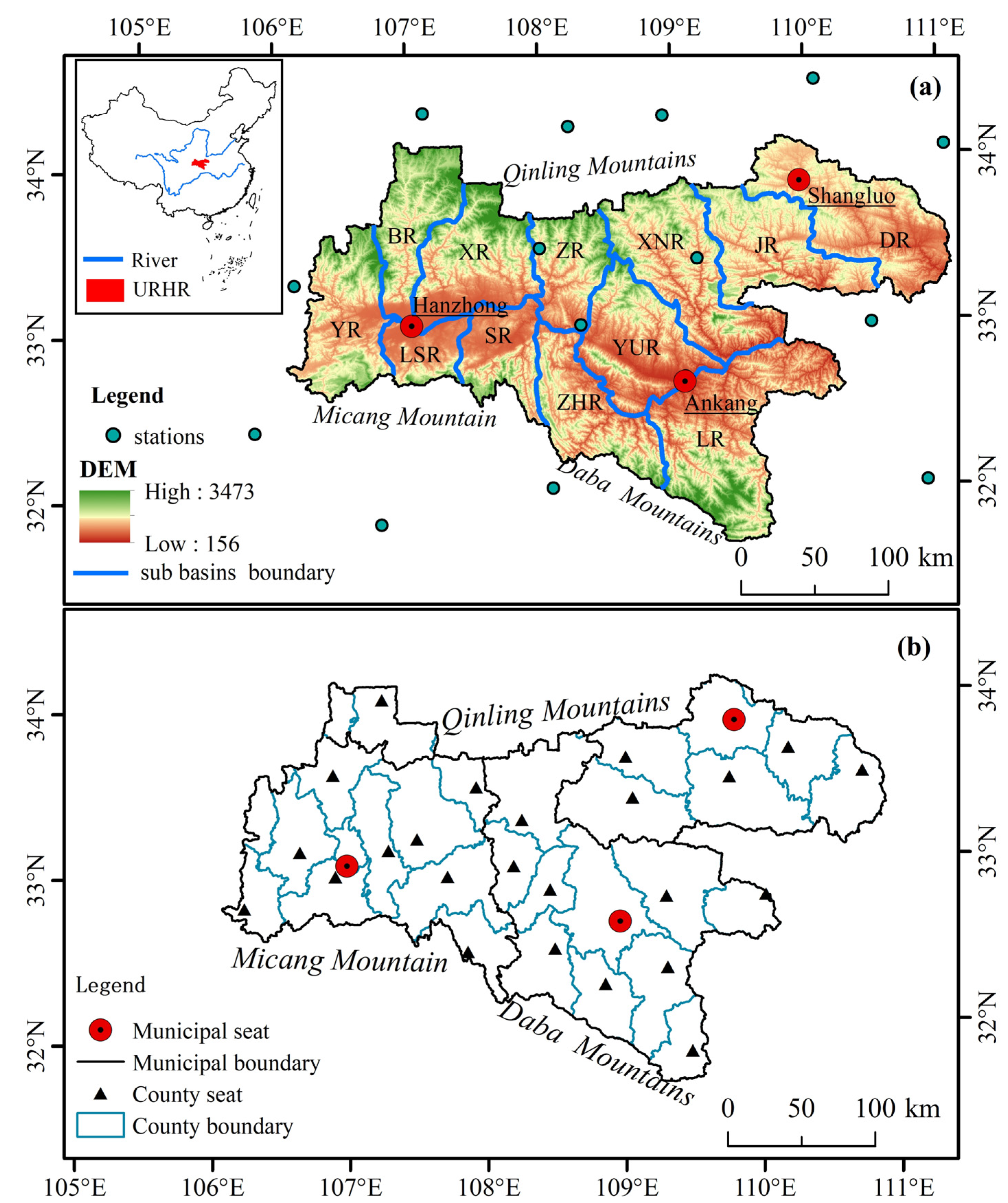
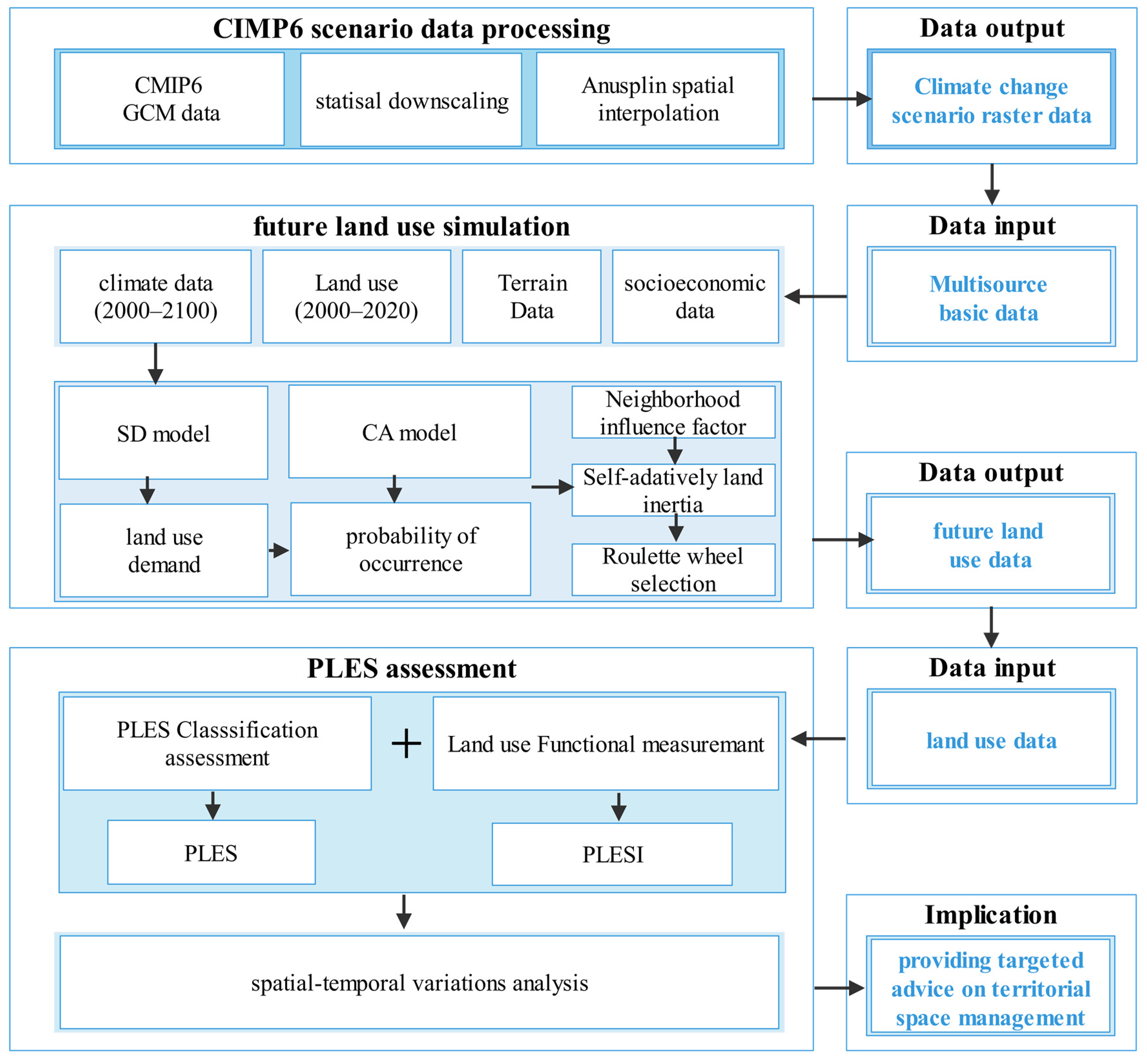
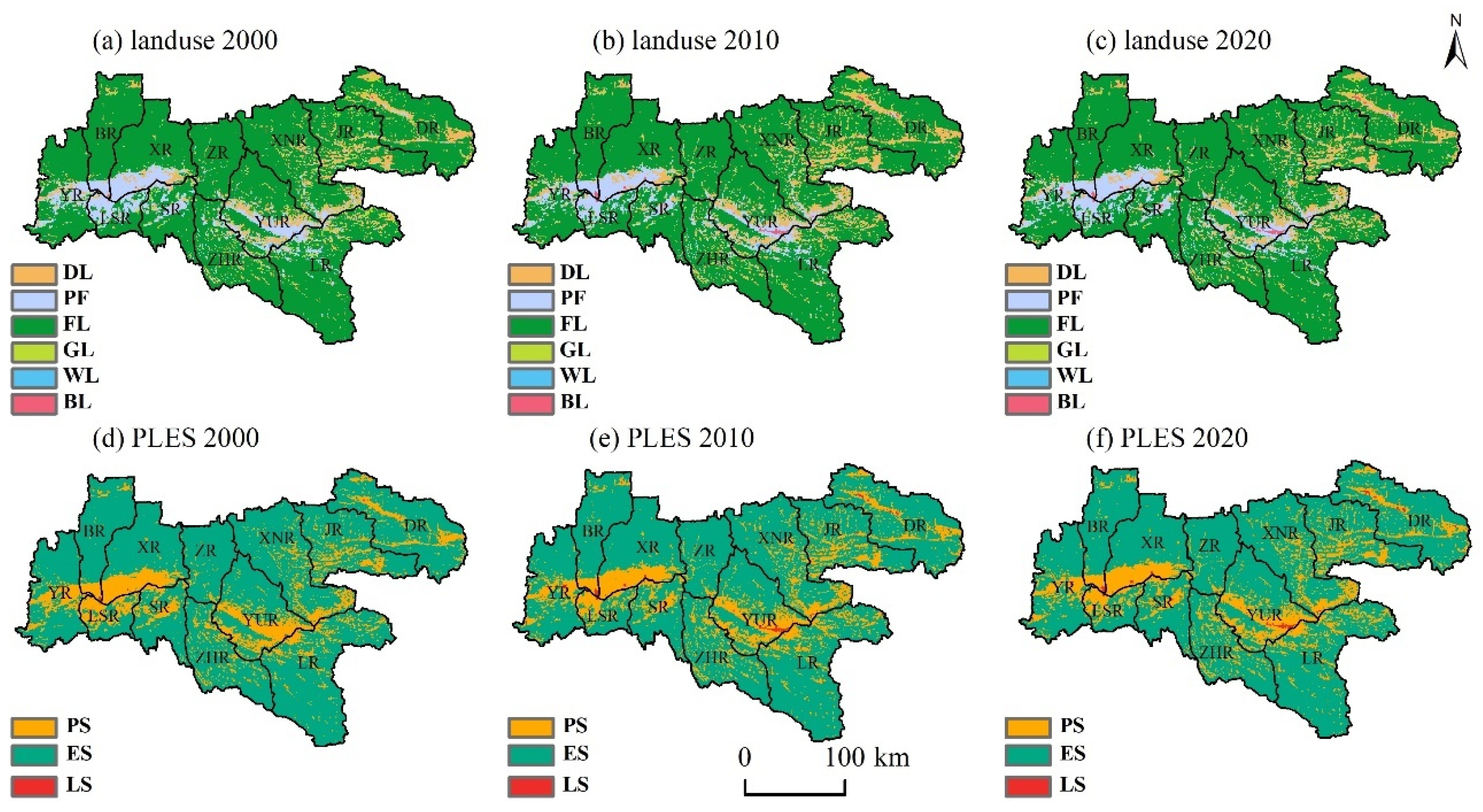

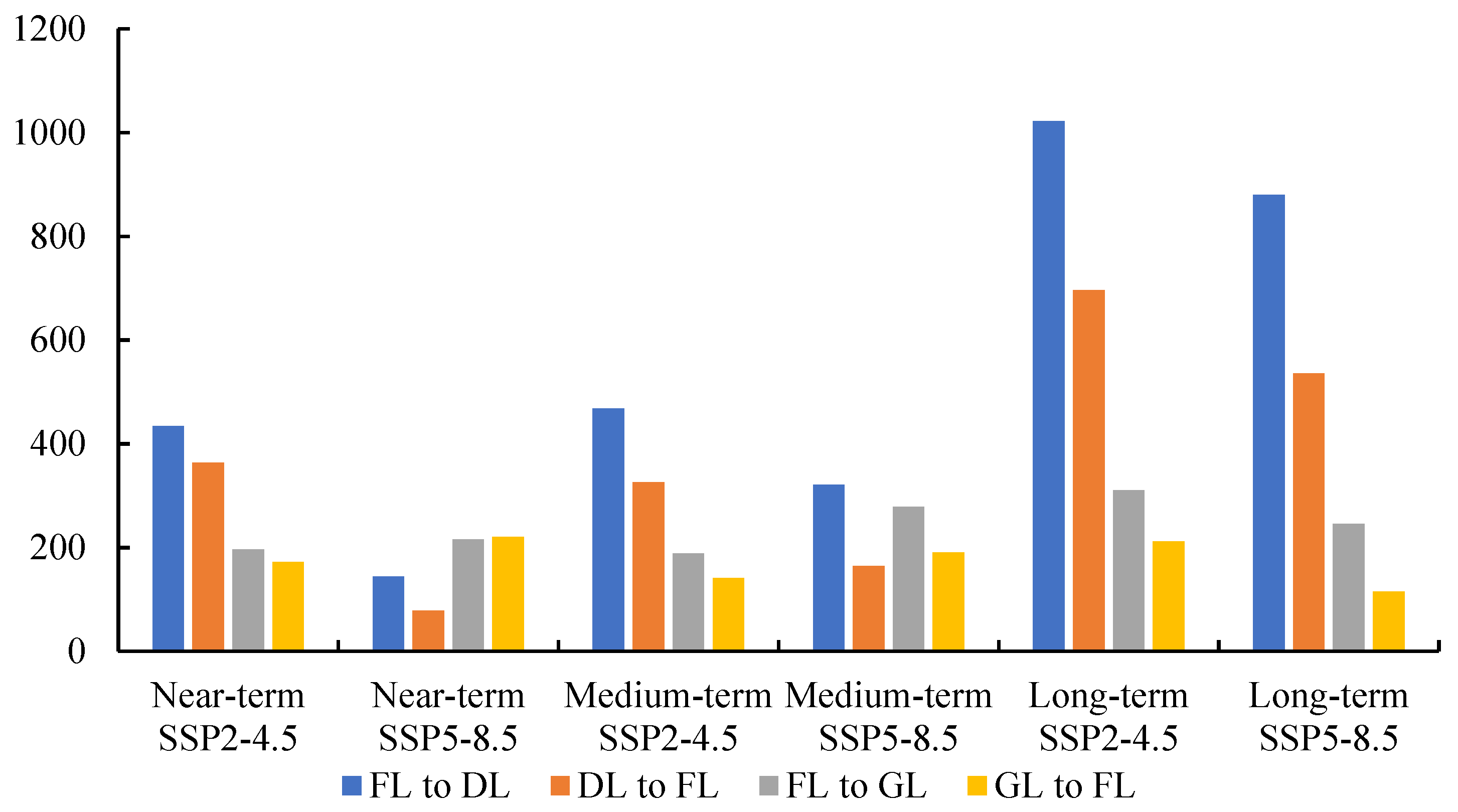
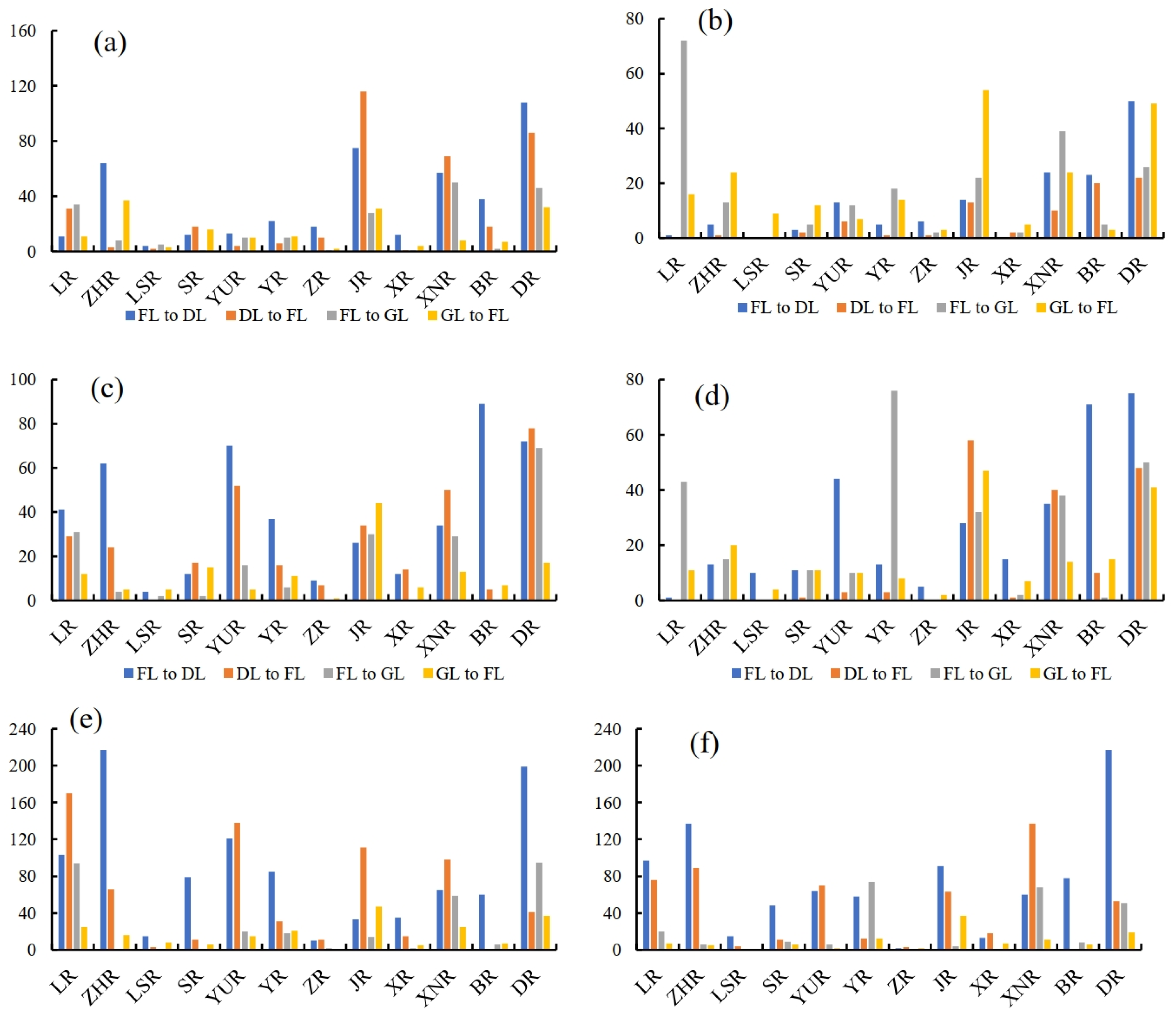

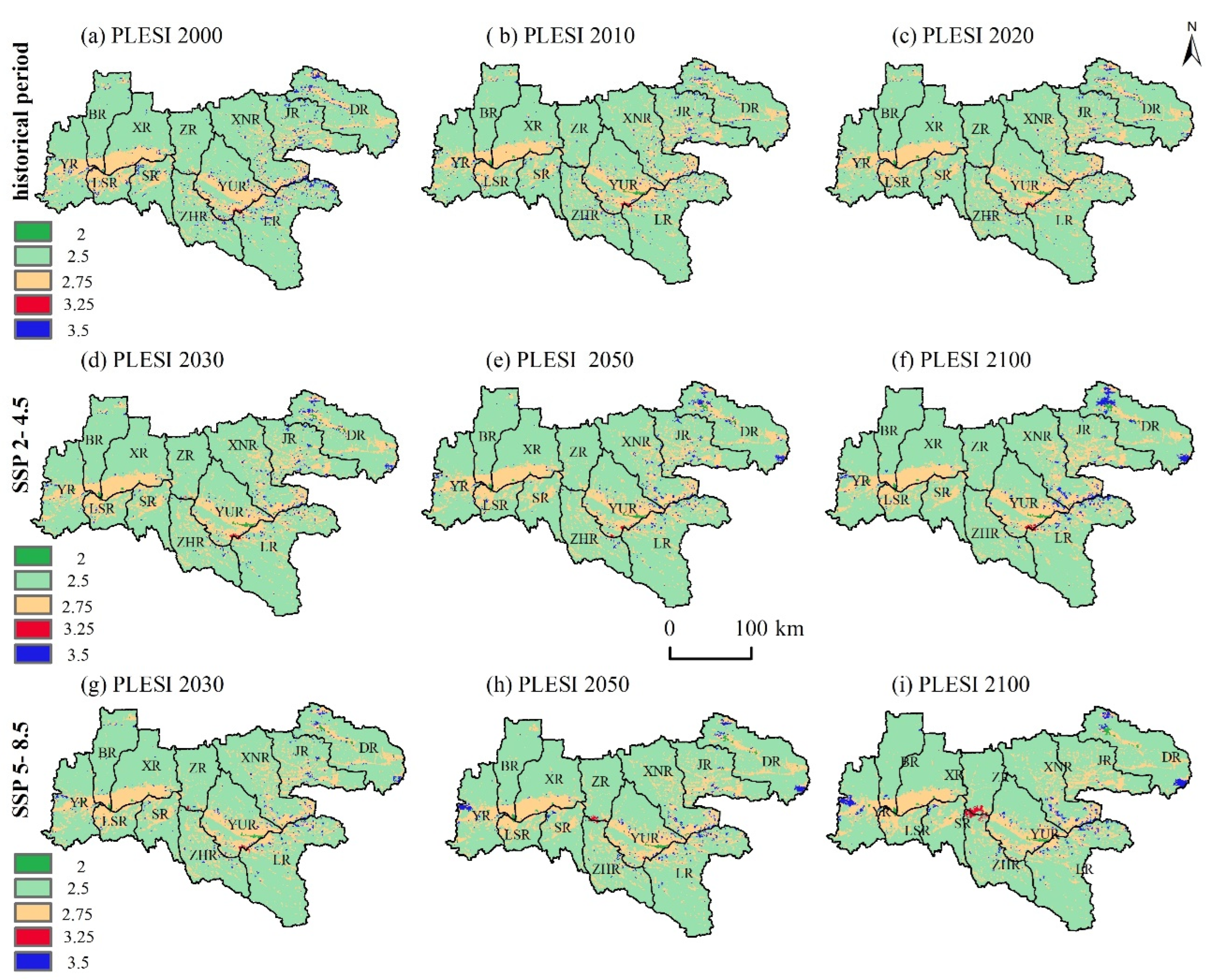
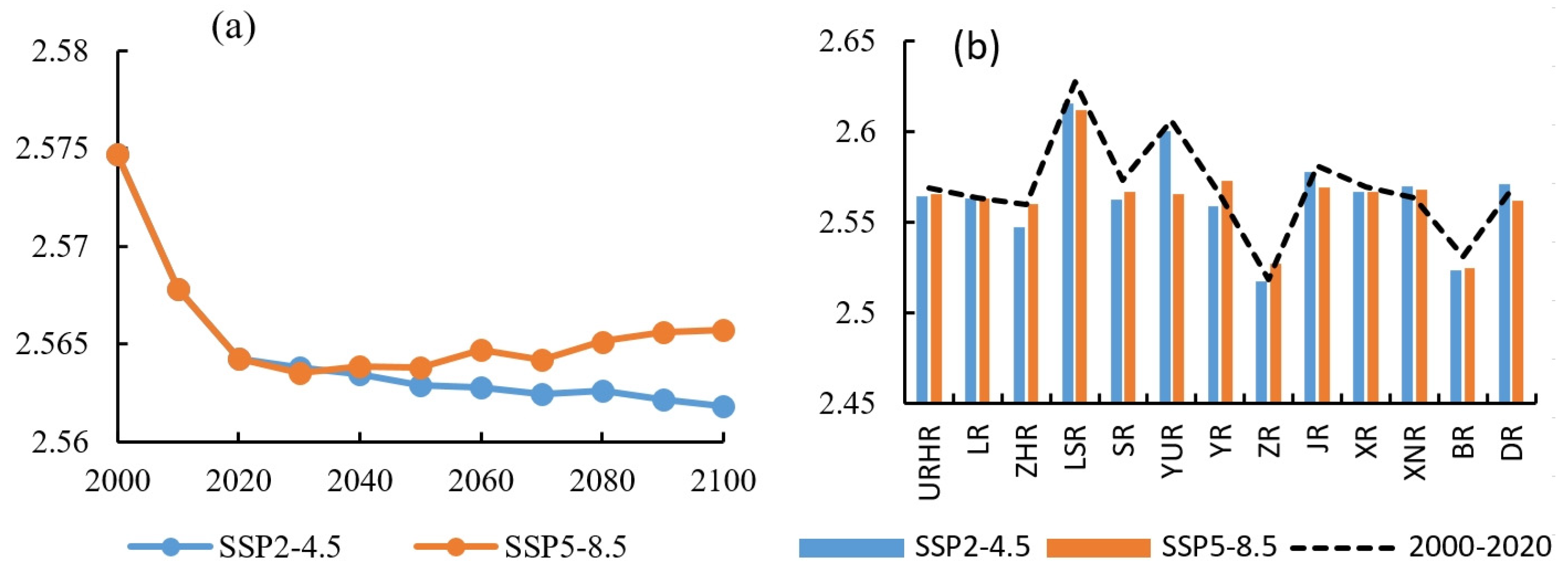
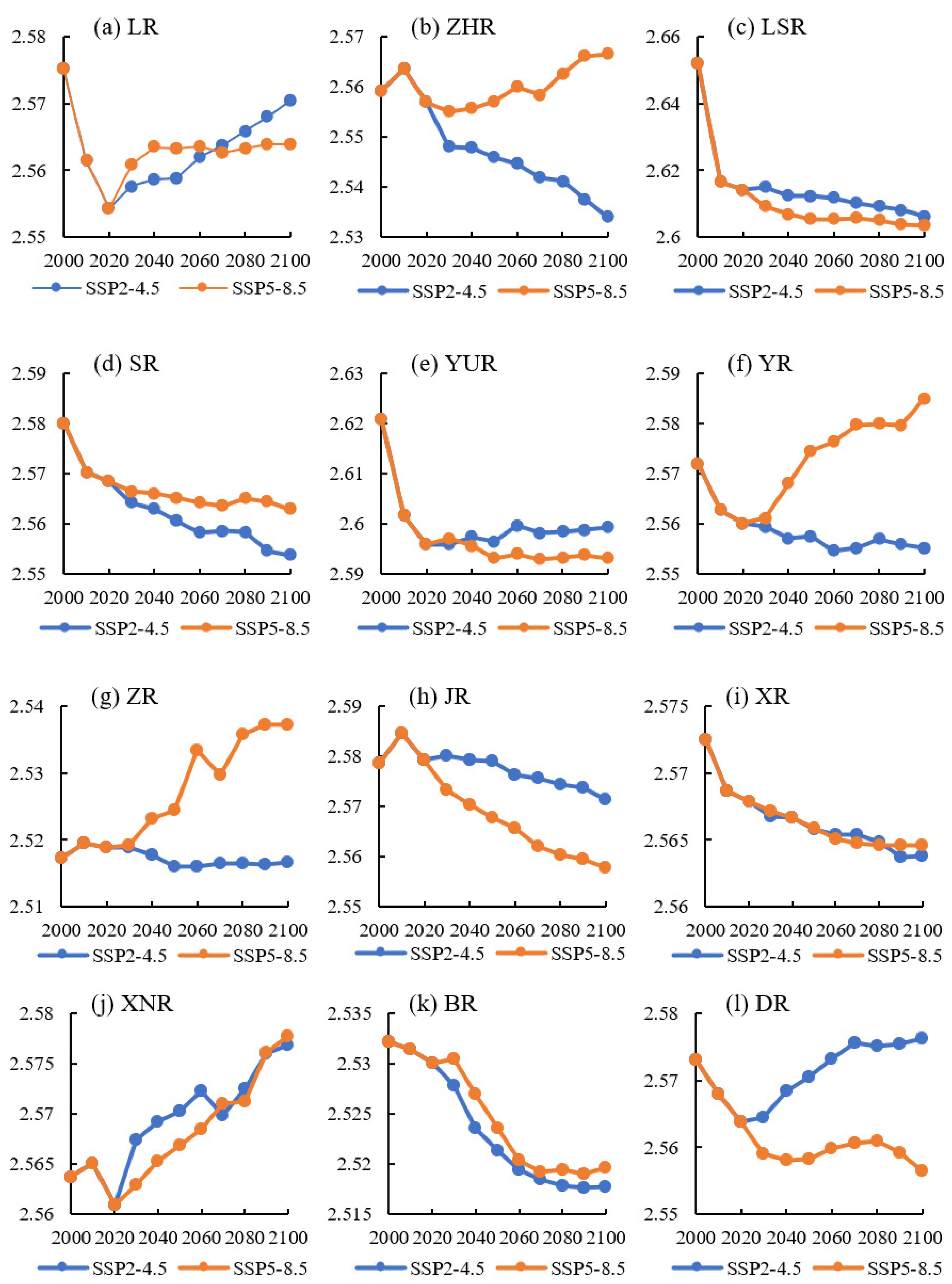
| Data Category | Data Name | Time Resolution | Spatial Resolution | Data Sources |
|---|---|---|---|---|
| Land use | - | 2000–2020 | 300 m | ESA CCI Land Cover project (https://cds.climate.copernicus.eu/cdsapp#!/dataset/satellite-land-cover?tab=overview accessed on 20 September 2021) |
| Climate data | temperature precipitation | 2000–2020 | Meteorological station | China Meteorology Administration (http://data.cma.cn accessed on 10 December 2021) |
| Climate scenarios | temperature precipitation | 2021–2100 | - | World Climate Research Programme (https://esgf-node.llnl.gov/search/cmip6/ accessed on 1 July 2021) |
| Terrain Data | DEM | 2003 | 30 m | NASA Shuttle Radar Topographic Mission (https://srtm.csi.cgiar.org/ accessed on 15 June 2020) |
| Socioeconomic data | GDP population | 2015 | 1 km | 1 km Grid GDP, 1 km Grid population of Chinese Academy of Sciences (www.resdc.cn/ accessed on 20 June 2020) |
| residential site | 2020 | vector data | National Geographic Information Data (www.webmap.cn/commres.do?method=dataDownload accessed on 3 September 2021) | |
| traffic network |
| PLES | Land Use | Production Function | Ecological Function | Living Function |
|---|---|---|---|---|
| production space | dryland | 5 | 3 | 0 |
| paddy field | 5 | 3 | 0 | |
| ecological space | forest land | 0 | 5 | 0 |
| grassland | 3 | 5 | 1 | |
| water land | 3 | 5 | 0 | |
| living space | building land | 3 | 0 | 5 |
| Research Period | PLES | SSP 2-4.5 | SSP 5-8.5 | ||||
|---|---|---|---|---|---|---|---|
| PS | ES | LS | PS | ES | LS | ||
| 2020–2030 | PS | 12,216 | 373 | 1 | 12,495 | 96 | 0 |
| ES | 459 | 49,422 | 0 | 178 | 49,701 | 1 | |
| LS | 5 | 5 | 211 | 7 | 3 | 211 | |
| 2030–2050 | PS | 12,056 | 356 | 1 | 12,203 | 208 | 3 |
| ES | 521 | 49,522 | 1 | 380 | 49,661 | 2 | |
| LS | 13 | 3 | 219 | 8 | 11 | 216 | |
| 2050–2100 | PS | 11,200 | 790 | 0 | 11,419 | 571 | 0 |
| ES | 1201 | 49,245 | 1 | 981 | 49,465 | 1 | |
| LS | 12 | 9 | 234 | 14 | 7 | 234 | |
Disclaimer/Publisher’s Note: The statements, opinions and data contained in all publications are solely those of the individual author(s) and contributor(s) and not of MDPI and/or the editor(s). MDPI and/or the editor(s) disclaim responsibility for any injury to people or property resulting from any ideas, methods, instructions or products referred to in the content. |
© 2023 by the authors. Licensee MDPI, Basel, Switzerland. This article is an open access article distributed under the terms and conditions of the Creative Commons Attribution (CC BY) license (https://creativecommons.org/licenses/by/4.0/).
Share and Cite
Wang, P.; Li, X.; Zhang, L.; Wang, Z.; Bai, J.; Song, Y.; Han, H.; Zhao, T.; Huang, G.; Yan, J. Spatiotemporal Variations of Production–Living–Ecological Space under Various, Changing Climate and Land Use Scenarios in the Upper Reaches of Hanjiang River Basin, China. Land 2023, 12, 1770. https://doi.org/10.3390/land12091770
Wang P, Li X, Zhang L, Wang Z, Bai J, Song Y, Han H, Zhao T, Huang G, Yan J. Spatiotemporal Variations of Production–Living–Ecological Space under Various, Changing Climate and Land Use Scenarios in the Upper Reaches of Hanjiang River Basin, China. Land. 2023; 12(9):1770. https://doi.org/10.3390/land12091770
Chicago/Turabian StyleWang, Pengtao, Xupu Li, Liwei Zhang, Zhuangzhuang Wang, Jiangtao Bai, Yongyong Song, Hongzhu Han, Ting Zhao, Guan Huang, and Junping Yan. 2023. "Spatiotemporal Variations of Production–Living–Ecological Space under Various, Changing Climate and Land Use Scenarios in the Upper Reaches of Hanjiang River Basin, China" Land 12, no. 9: 1770. https://doi.org/10.3390/land12091770
APA StyleWang, P., Li, X., Zhang, L., Wang, Z., Bai, J., Song, Y., Han, H., Zhao, T., Huang, G., & Yan, J. (2023). Spatiotemporal Variations of Production–Living–Ecological Space under Various, Changing Climate and Land Use Scenarios in the Upper Reaches of Hanjiang River Basin, China. Land, 12(9), 1770. https://doi.org/10.3390/land12091770









